Framework for Geometric Information Extraction and Digital Modeling from LiDAR Data of Road Scenarios
Abstract
1. Introduction
- (1)
- An improved semantic segmentation network that accurately and efficiently divides the road surface and other infrastructure.
- (2)
- A series of geometric information extraction methods that can be used to obtain the road boundary and centerline, and to calculate the geometric elements of roads. These can be applied to the segmented point clouds that contain 3D coordinates and RGB information. Note that the extraction methods do not aim to be the contribution. However, these are essential for the entire workflow and would be validated if the mean absolute errors between the extracted and manually measured geometric information were marginal.
- (3)
- A digital modeling process that constructs a road entity model and various infrastructure components to realize a geometric representation.
2. Materials and Methods
2.1. Point Clouds Obtained by Different LiDAR Systems
2.2. Methods Overview
2.3. Semantic Segmentation of Point Clouds
2.3.1. Improved SCF Module
- Local Polar Representation
- 2.
- Aggregated Attentive Pooling
- 3.
- Global Contextual Feature Representation
2.3.2. Architecture of Improved SCF-Net
2.4. Process of Road Geometric Information Extraction
2.5. BIM Technology for Digital Modeling
3. Results
3.1. Datasets and Implementation Detail
3.2. Semantic Segmentation on Benchmarks
3.2.1. Evaluation on Toronto-3D
3.2.2. Evaluation on Semantic3D
3.3. Results of Road Geometric Information Extraction
3.4. Digital Modeling in BIM Environment
4. Discussion
5. Conclusions
Author Contributions
Funding
Data Availability Statement
Acknowledgments
Conflicts of Interest
References
- Jiang, F.; Ma, L.; Broyd, T.; Chen, W.; Luo, H. Building Digital Twins of Existing Highways Using Map Data Based on Engineering Expertise. Autom. Constr. 2022, 134, 104081. [Google Scholar] [CrossRef]
- Jalayer, M.; Gong, J.; Zhou, H.; Grinter, M. Evaluation of Remote Sensing Technologies for Collecting Roadside Feature Data to Support Highway Safety Manual Implementation. J. Transp. Saf. Secur. 2015, 7, 345–357. [Google Scholar] [CrossRef]
- Vaiana, R.; Perri, G.; Iuele, T.; Gallelli, V. A Comprehensive Approach Combining Regulatory Procedures and Accident Data Analysis for Road Safety Management Based on the European Directive 2019/1936/Ec. Safety 2021, 7, 6. [Google Scholar] [CrossRef]
- Hou, Q.; Ai, C. A Network-Level Sidewalk Inventory Method Using Mobile LiDAR and Deep Learning. Transp. Res. Part C Emerg. Technol. 2020, 119, 102772. [Google Scholar] [CrossRef]
- Holgado-Barco, A.; González-Aguilera, D.; Arias-Sanchez, P.; Martinez-Sanchez, J. Semiautomatic Extraction of Road Horizontal Alignment from a Mobile LiDAR System. Comput.-Aided Civ. Infrastruct. Eng. 2015, 30, 217–228. [Google Scholar] [CrossRef]
- Gu, H.; Han, Y.; Yang, Y.; Li, H.; Liu, Z.; Soergel, U.; Blaschke, T.; Cui, S. An Efficient Parallel Multi-Scale Segmentation Method for Remote Sensing Imagery. Remote Sens. 2018, 10, 590. [Google Scholar] [CrossRef]
- Holgado-Barco, A.; Riveiro, B.; González-Aguilera, D.; Arias, P. Automatic Inventory of Road Cross-Sections from Mobile Laser Scanning System. Comput.-Aided Civ. Infrastruct. Eng. 2017, 32, 3–17. [Google Scholar] [CrossRef]
- Qiu, S.; Anwar, S.; Barnes, N. Semantic Segmentation for Real Point Cloud Scenes via Bilateral Augmentation and Adaptive Fusion. In Proceedings of the IEEE Computer Society Conference on Computer Vision and Pattern Recognition, Nashville, TN, USA, 20–25 June 2021; pp. 1757–1767. [Google Scholar]
- Lin, Y.; Vosselman, G.; Cao, Y.; Yang, M.Y. Active and Incremental Learning for Semantic ALS Point Cloud Segmentation. ISPRS J. Photogramm. Remote Sens. 2020, 169, 73–92. [Google Scholar] [CrossRef]
- Pierdicca, R.; Paolanti, M.; Matrone, F.; Martini, M.; Morbidoni, C.; Malinverni, E.S.; Frontoni, E.; Lingua, A.M. Point Cloud Semantic Segmentation Using a Deep Learning Framework for Cultural Heritage. Remote Sens. 2020, 12, 1005. [Google Scholar] [CrossRef]
- Han, X.; Dong, Z.; Yang, B. A Point-Based Deep Learning Network for Semantic Segmentation of MLS Point Clouds. ISPRS ISPRS J. Photogramm. Remote Sens. 2021, 175, 199–214. [Google Scholar] [CrossRef]
- Rodríguez-Cuenca, B.; García-Cortés, S.; Ordóñez, C.; Alonso, M.C. An Approach to Detect and Delineate Street Curbs from MLS 3D Point Cloud Data. Autom. Constr. 2015, 51, 103–112. [Google Scholar] [CrossRef]
- Ibrahim, S.; Lichti, D. Curb-Based Street Floor Extraction From Mobile Terrestrial Lidar Point Cloud. ISPRS-Int. Arch. Photogramm. Remote Sens. Spat. Inf. Sci. 2012, XXXIX-B5, 193–198. [Google Scholar] [CrossRef]
- Xu, S.; Wang, R.; Zheng, H. Road Curb Extraction from Mobile LiDAR Point Clouds. IEEE Trans. Geosci. Remote Sens. 2017, 55, 996–1009. [Google Scholar] [CrossRef]
- Kumar, P.; McElhinney, C.P.; Lewis, P.; McCarthy, T. An Automated Algorithm for Extracting Road Edges from Terrestrial Mobile LiDAR Data. ISPRS J. Photogramm. Remote Sens. 2013, 85, 44–55. [Google Scholar] [CrossRef]
- Kumar, P.; Lewis, P.; McCarthy, T. The Potential of Active Contour Models in Extracting Road Edges from Mobile Laser Scanning Data. Infrastructures 2017, 2, 9. [Google Scholar] [CrossRef]
- Guo, J.; Tsai, M.J.; Han, J.Y. Automatic Reconstruction of Road Surface Features by Using Terrestrial Mobile Lidar. Autom. Constr. 2015, 58, 165–175. [Google Scholar] [CrossRef]
- Yadav, M.; Singh, A.K.; Lohani, B. Extraction of Road Surface from Mobile LiDAR Data of Complex Road Environment. Int. J. Remote Sens. 2017, 38, 4645–4672. [Google Scholar] [CrossRef]
- Guo, Y.; Wang, H.; Hu, Q.; Liu, H.; Liu, L.; Bennamoun, M. Deep Learning for 3D Point Clouds: A Survey. IEEE Trans. Pattern. Anal. Mach. Intell. 2021, 43, 4338–4364. [Google Scholar] [CrossRef]
- Lawin, F.J.; Danelljan, M.; Tosteberg, P.; Bhat, G.; Khan, F.S.; Felsberg, M. Deep Projective 3D Semantic Segmentation. Lect. Notes Comput. Sci. 2017, 10424 LNCS, 95–107. [Google Scholar]
- Tchapmi, L.; Choy, C.; Armeni, I.; Gwak, J.; Savarese, S. SEGCloud: Semantic Segmentation of 3D Point Clouds. In Proceedings of the 2017 International Conference on 3D Vision, (3DV), Qingdao, China, 10–12 October 2017; pp. 537–547. [Google Scholar]
- Graham, B.; Engelcke, M.; Van Der Maaten, L. 3D Semantic Segmentation with Submanifold Sparse Convolutional Networks. In Proceedings of the IEEE Computer Society Conference on Computer Vision and Pattern Recognition, Salt Lake City, UT, USA, 18–23 June 2018; pp. 9224–9232. [Google Scholar]
- Meng, H.Y.; Gao, L.; Lai, Y.K.; Manocha, D. VV-Net: Voxel VAE Net with Group Convolutions for Point Cloud Segmentation. In Proceedings of the IEEE International Conference on Computer Vision 2019, Seoul, Republic of Korea, 27 October–2 November 2019; pp. 8499–8507. [Google Scholar]
- Sha, A.; Yun, D.; Hu, L.; Tang, C. Influence of Sampling Interval and Evaluation Area on the Three-Dimensional Pavement Parameters. Road Mater. Pavement Des. 2021, 22, 1964–1985. [Google Scholar] [CrossRef]
- Jing, H.; You, S. Point Cloud Labeling Using 3D Convolutional Neural Network. In Proceedings of the International Conference on Pattern Recognition, Cancun, Mexico, 4–8 December 2016; pp. 2670–2675. [Google Scholar]
- Hu, Q.; Yang, B.; Xie, L.; Rosa, S.; Guo, Y.; Wang, Z.; Trigoni, N.; Markham, A. Learning Semantic Segmentation of Large-Scale Point Clouds With Random Sampling. IEEE Trans. Pattern Anal. Mach. Intell. 2021, 44, 1. [Google Scholar] [CrossRef]
- Fan, S.Q.; Dong, Q.L.; Zhu, F.H.; Lv, Y.S.; Ye, P.J.; Wang, F.Y.; Ieee Comp, S.O.C. SCF-Net: Learning Spatial Contextual Features for Large-Scale Point Cloud Segmentation. In Proceedings of the IEEE/CVF Conference on Computer Vision and Pattern Recognition (CVPR), Nashville, TN, USA, 20–25 June 2021; pp. 14499–14508. [Google Scholar]
- Yang, X.; Tang, L.; Niu, L.; Zhang, X.; Li, Q. Generating Lane-Based Intersection Maps from Crowdsourcing Big Trace Data. Transp. Res. Part C Emerg. Technol. 2018, 89, 168–187. [Google Scholar] [CrossRef]
- Zhang, Z.; Li, J.; Guo, Y.; Yang, C.; Wang, C. 3D Highway Curve Reconstruction from Mobile Laser Scanning Point Clouds. IEEE Trans. Intell. Transp. Syst. 2020, 21, 4762–4772. [Google Scholar] [CrossRef]
- Strygulec, S.; Muller, D.; Meuter, M.; Nunn, C.; Ghosh, S.; Wohler, C. Road Boundary Detection and Tracking Using Monochrome Camera Images. In Proceedings of the 16th International Conference on Information Fusion, (FUSION 2013), Istanbul, Turkey, 9–12 July 2013; pp. 864–870. [Google Scholar]
- Mi, X.; Yang, B.; Dong, Z.; Chen, C.; Gu, J. Automated 3D Road Boundary Extraction and Vectorization Using MLS Point Clouds. IEEE Trans. Intell. Transp. Syst. 2022, 23, 5287–5297. [Google Scholar] [CrossRef]
- Di Mascio, P.; Di Vito, M.; Loprencipe, G.; Ragnoli, A. Procedure to Determine the Geometry of Road Alignment Using GPS Data. Procedia Soc. Behav. Sci. 2012, 53, 1202–1215. [Google Scholar] [CrossRef]
- Justo, A.; Soilán, M.; Sánchez-Rodríguez, A.; Riveiro, B. Scan-to-BIM for the Infrastructure Domain: Generation of IFC-Complaint Models of Road Infrastructure Assets and Semantics Using 3D Point Cloud Data. Autom. Constr. 2021, 127, 13. [Google Scholar] [CrossRef]
- Soilán, M.; Justo, A.; Sánchez-Rodríguez, A.; Riveiro, B. 3D Point Cloud to BIM: Semi-Automated Framework to Define IFC Alignment Entities from MLS-Acquired LiDAR Data of Highway Roads. Remote Sens. 2020, 12, 2301. [Google Scholar] [CrossRef]
- Tang, F.; Ma, T.; Zhang, J.; Guan, Y.; Chen, L. Integrating Three-Dimensional Road Design and Pavement Structure Analysis Based on BIM. Autom. Constr. 2020, 113, 17. [Google Scholar] [CrossRef]
- Soilan, M.; Sanchez-Rodriguez, A.; del Rio-Barral, P.; Perez-Collazo, C.; Arias, P.; Riveiro, B. Review of Laser Scanning Technologies and Their Applications for Road and Railway Infrastructure Monitoring. Infrastructures 2019, 4, 58. [Google Scholar] [CrossRef]
- Olsen, M.J.; Kuester, F.; Chang, B.J.; Hutchinson, T.C. Terrestrial Laser Scanning-Based Structural Damage Assessment. J. Comput. Civ. Eng. 2010, 24, 264–272. [Google Scholar] [CrossRef]
- Kukko, A.; Kaartinen, H.; Hyyppa, J.; Chen, Y.W. Multiplatform Mobile Laser Scanning: Usability and Performance. Sensors 2012, 12, 11712–11733. [Google Scholar] [CrossRef]
- Jaakkola, A.; Hyyppa, J.; Hyyppa, H.; Kukko, A. Retrieval Algorithms for Road Surface Modelling Using Laser-Based Mobile Mapping. Sensors 2008, 8, 5238–5249. [Google Scholar] [CrossRef] [PubMed]
- Zhang, C.; Xu, S.; Jiang, T.; Liu, J.; Liu, Z.; Luo, A.; Ma, Y. Integrating Normal Vector Features into an Atrous Convolution Residual Network for Lidar Point Cloud Classification. Remote Sens. 2021, 13, 3427. [Google Scholar] [CrossRef]
- Fang, L.; Shen, G.; You, Z.; Guo, Y.; Fu, H.; Zhao, Z.; Chen, C. A Joint Network of Point Cloud and Multiple Views for Roadside Objects Recognition from Mobile Laser Point Clouds. Cehui Xuebao/Acta Geod. Cartogr. Sin. 2021, 50, 1558–1573. [Google Scholar] [CrossRef]
- AlHajri, M.F.; El-Hawary, M.E. Exploiting the Radial Distribution Structure in Developing a Fast and Flexible Radial Power Flow for Unbalanced Three-Phase Networks. IEEE Trans. Power Deliv. 2010, 25, 378–389. [Google Scholar] [CrossRef]
- Guan, H.Y.; Li, J.; Yu, Y.T.; Chapman, M.; Wang, C. Automated Road Information Extraction From Mobile Laser Scanning Data. IEEE Trans. Intell. Transp. Syst. 2015, 16, 194–205. [Google Scholar] [CrossRef]
- Ma, Y.; Easa, S.; Cheng, J.C.A.; Yu, B. Automatic Framework for Detecting Obstacles Restricting 3D Highway Sight Distance Using Mobile Laser Scanning Data. J. Comput. Civ. Eng. 2021, 35, 19. [Google Scholar] [CrossRef]
- Al-Tamimi, M.S.H.; Sulong, G.; Shuaib, I.L. Alpha Shape Theory for 3D Visualization and Volumetric Measurement of Brain Tumor Progression Using Magnetic Resonance Images. Magn. Reson. Imaging 2015, 33, 787–803. [Google Scholar] [CrossRef]
- Widyaningrum, E.; Peters, R.Y.; Lindenbergh, R.C. Building Outline Extraction from ALS Point Clouds Using Medial Axis Transform Descriptors. Pattern Recognit. 2020, 106, 15. [Google Scholar] [CrossRef]
- Tejenaki, S.A.K.; Ebadi, H.; Mohammadzadeh, A. A New Hierarchical Method for Automatic Road Centerline Extraction in Urban Areas Using LIDAR Data. Adv. Space Res. 2019, 64, 1792–1806. [Google Scholar] [CrossRef]
- Younas, S.; Figley, C.R. Development, Implementation and Validation of an Automatic Centerline Extraction Algorithm for Complex 3D Objects. J. Med. Biol. Eng. 2019, 39, 184–204. [Google Scholar] [CrossRef]
- Tan, W.K.; Qin, N.N.; Ma, L.F.; Li, Y.; Du, J.; Cai, G.R.; Yang, K.; Li, J.; Ieee Comp, S.O.C. Toronto-3D: A Large-Scale Mobile LiDAR Dataset for Semantic Segmentation of Urban Roadways. In Proceedings of the IEEE/CVF Conference on Computer Vision and Pattern Recognition (CVPR), Seattle, WA, USA, 13–19 June 2020; pp. 797–806. [Google Scholar]
- Hackel, T.; Wegner, J.D.; Savinov, N.; Ladicky, L.; Schindler, K.; Pollefeys, M. Large-Scale Supervised Learning For 3D Point Cloud Labeling: Semantic3d.Net. Photogramm. Eng. Remote Sens. 2018, 84, 297–308. [Google Scholar] [CrossRef]
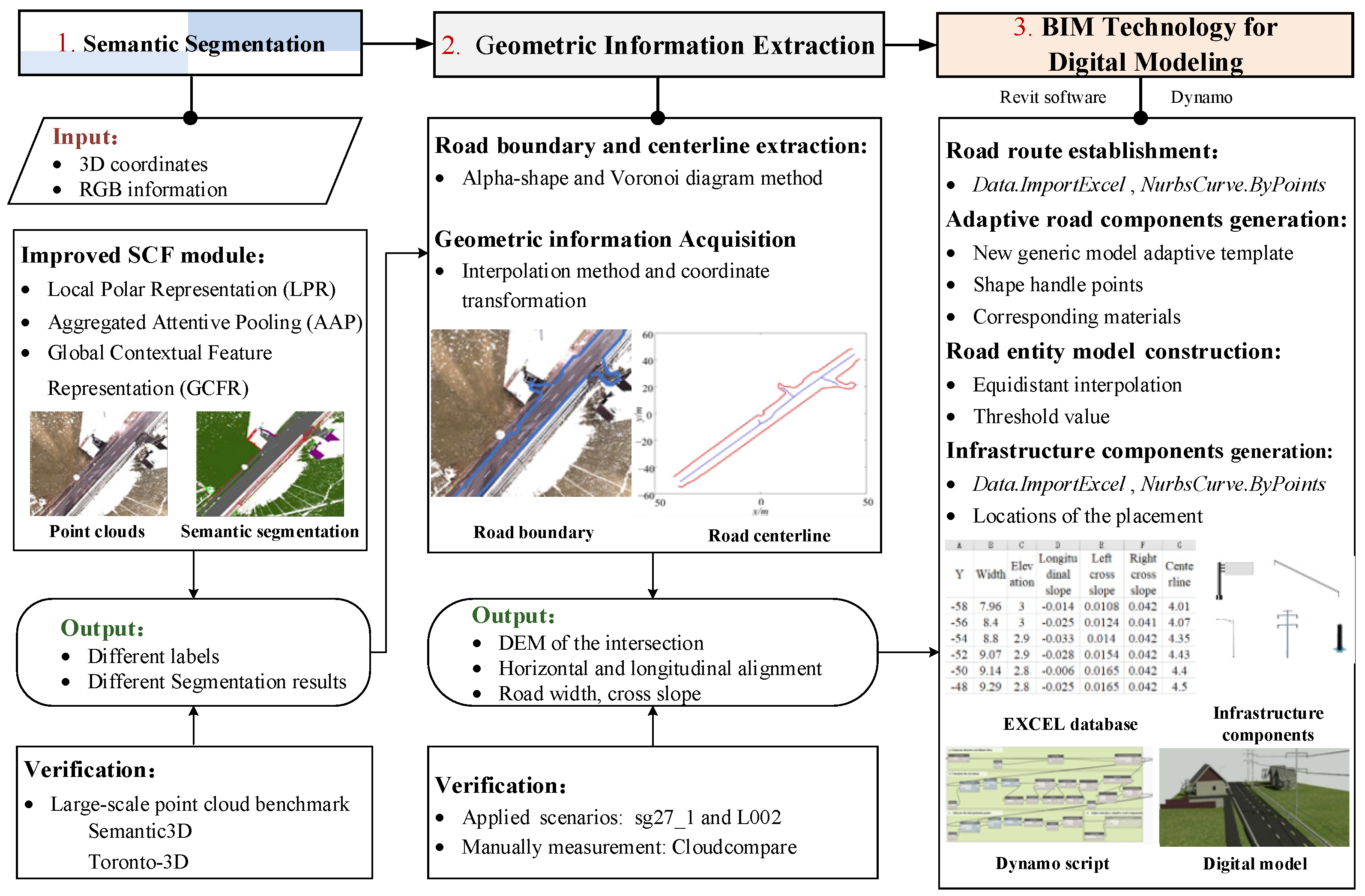
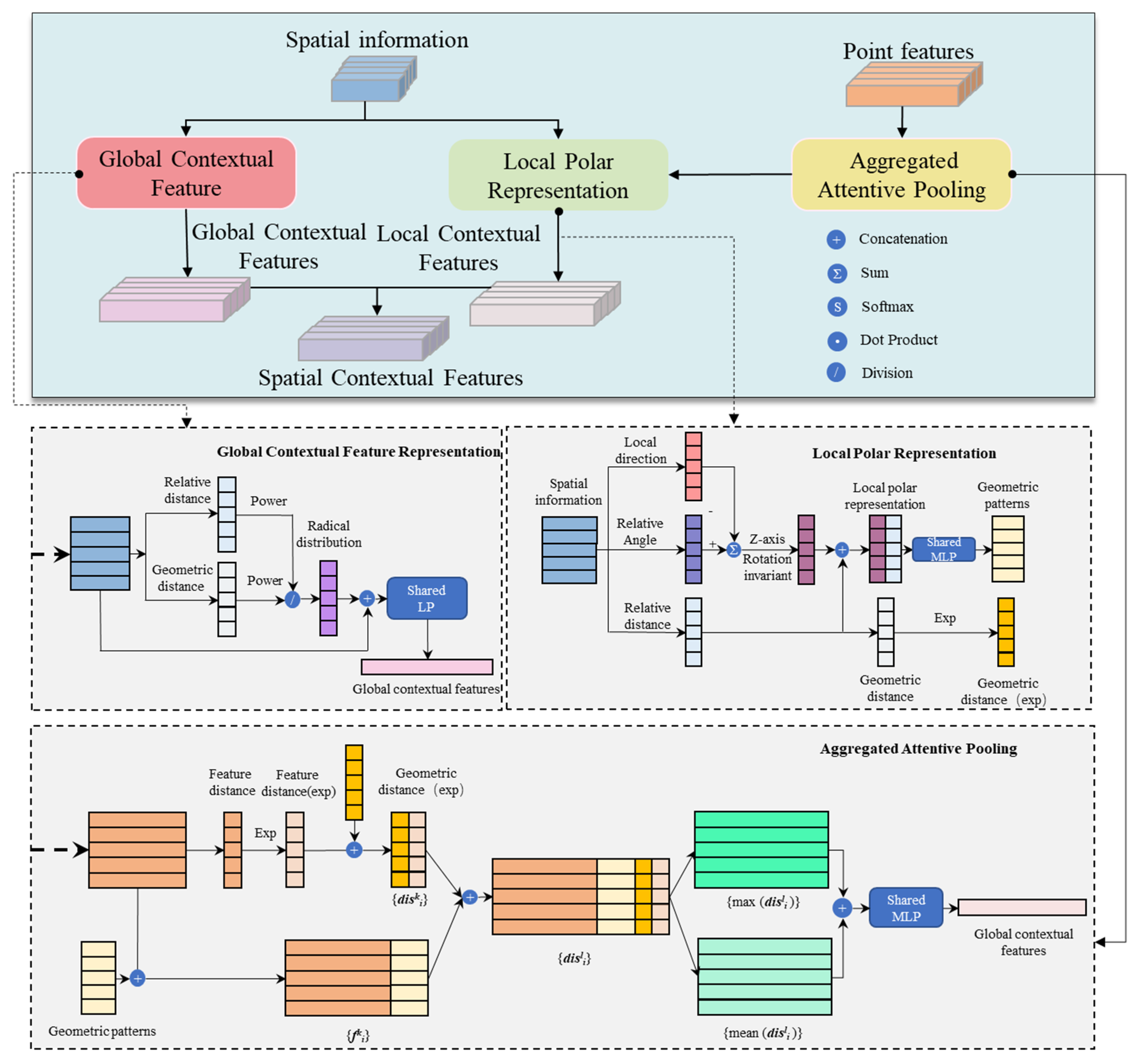

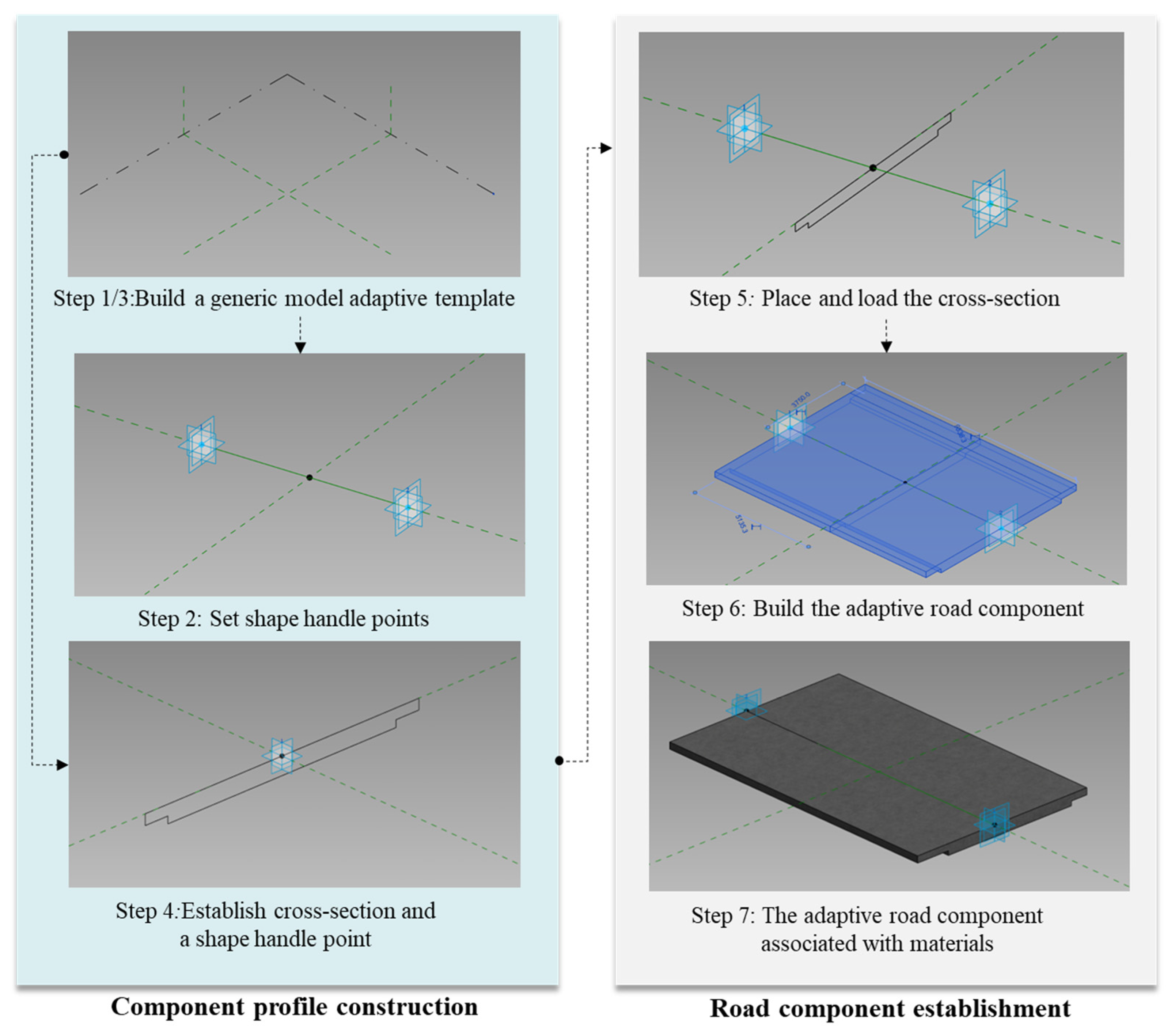


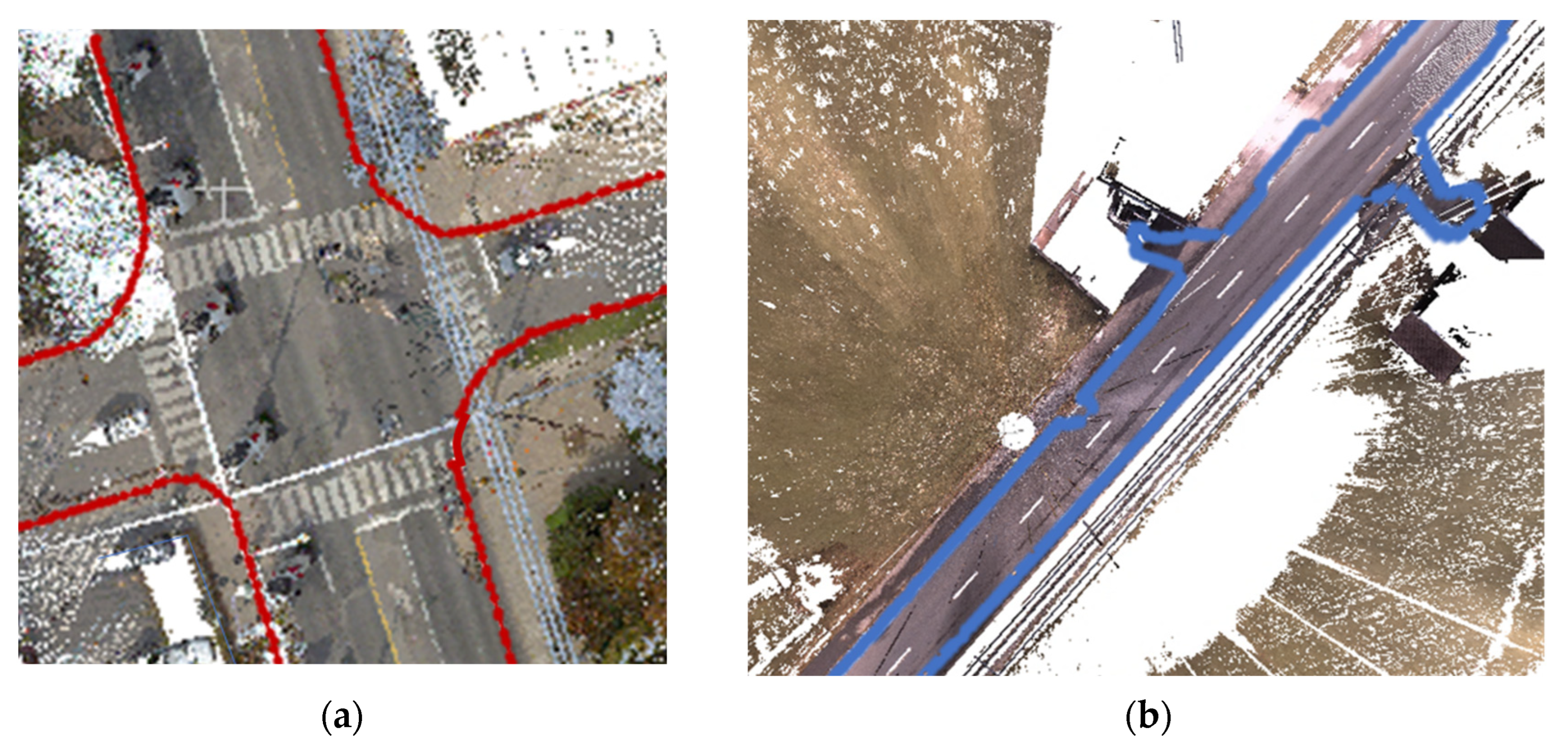
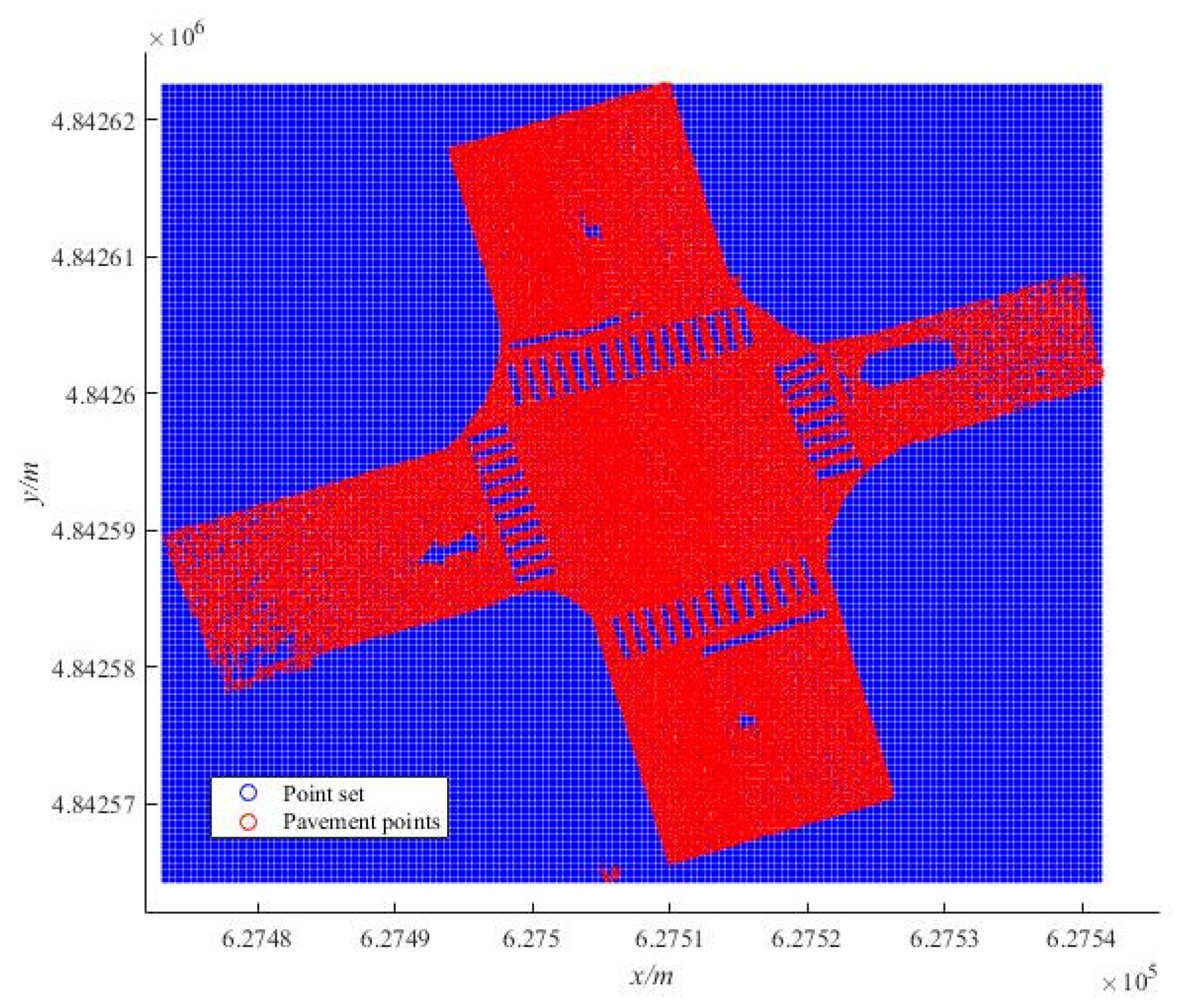
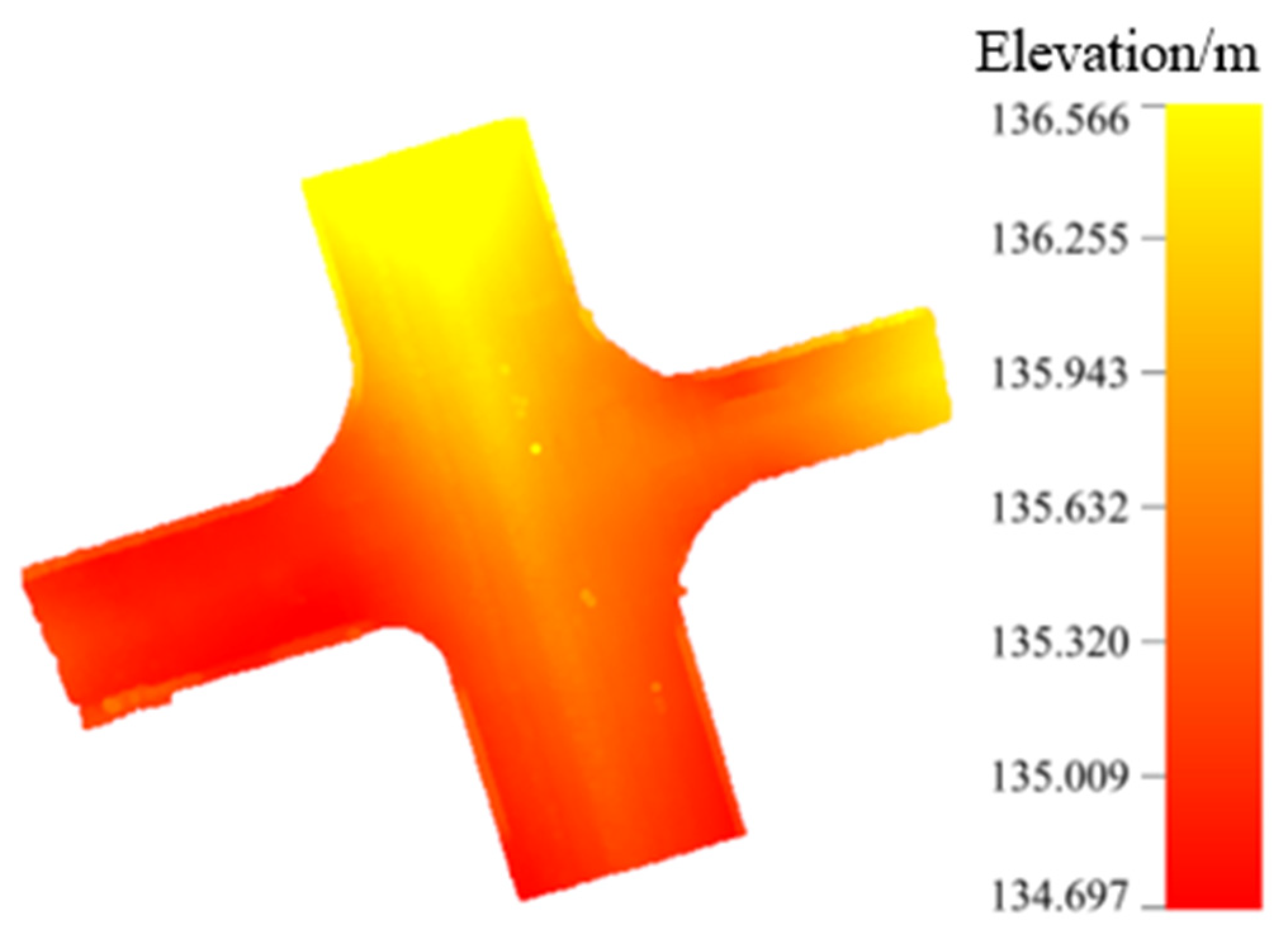
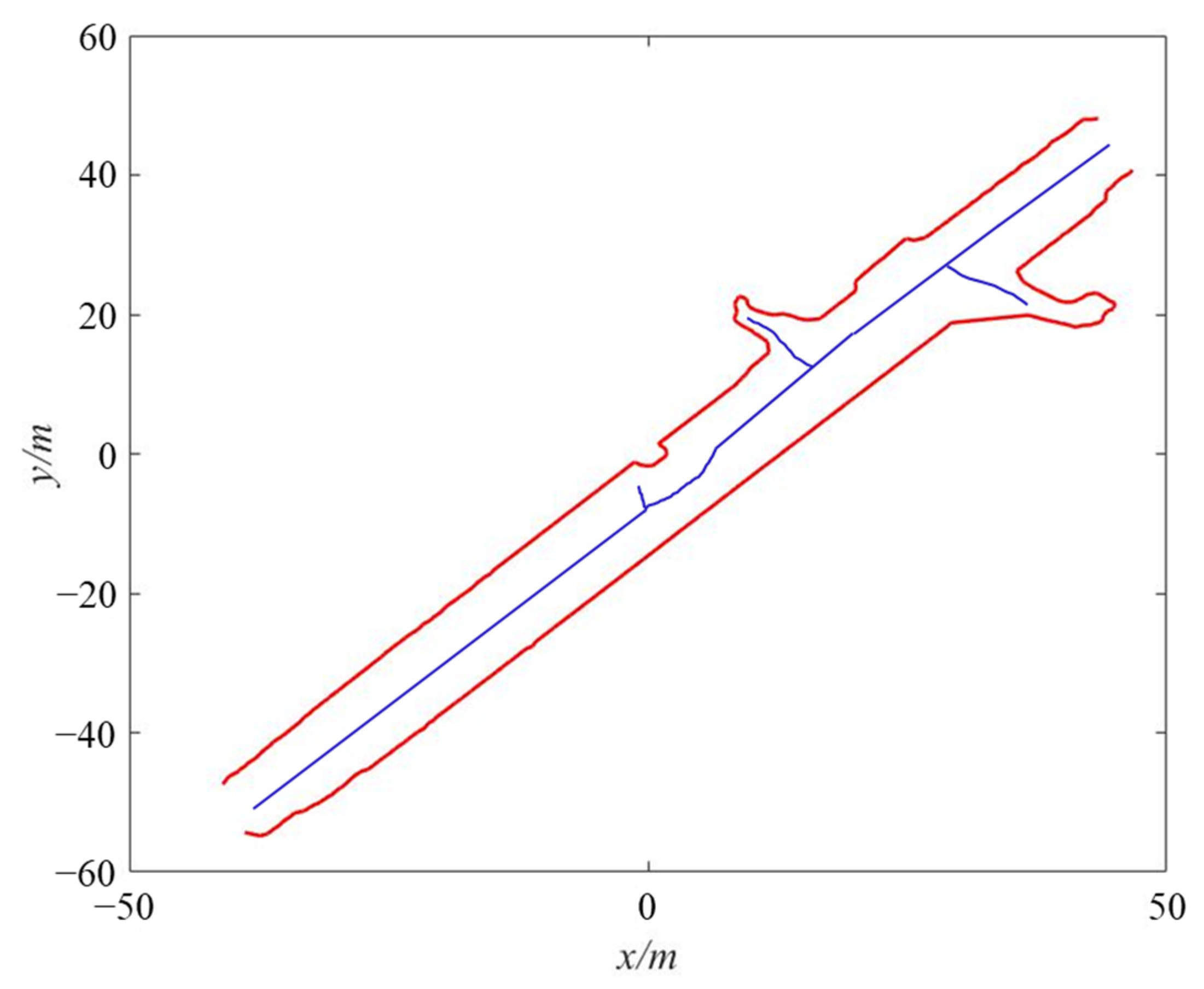
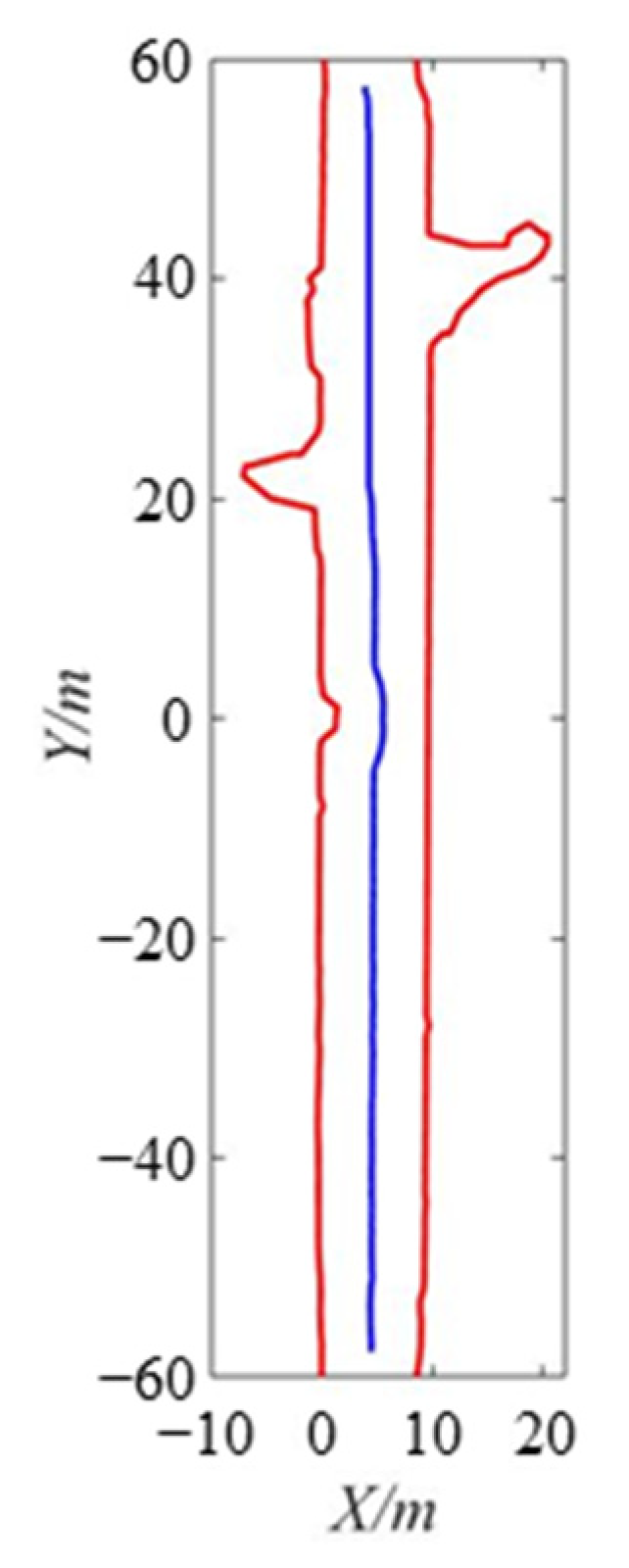
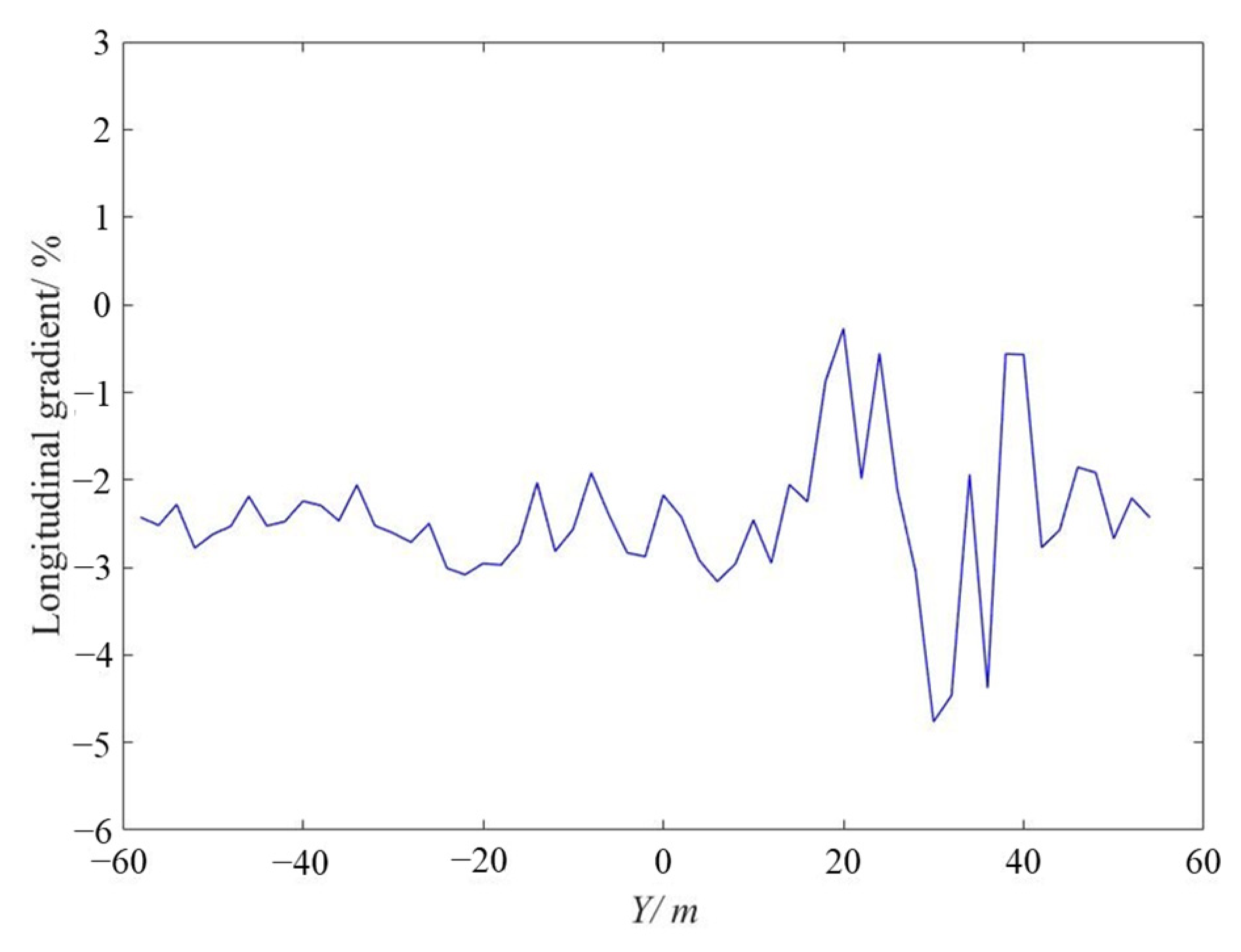
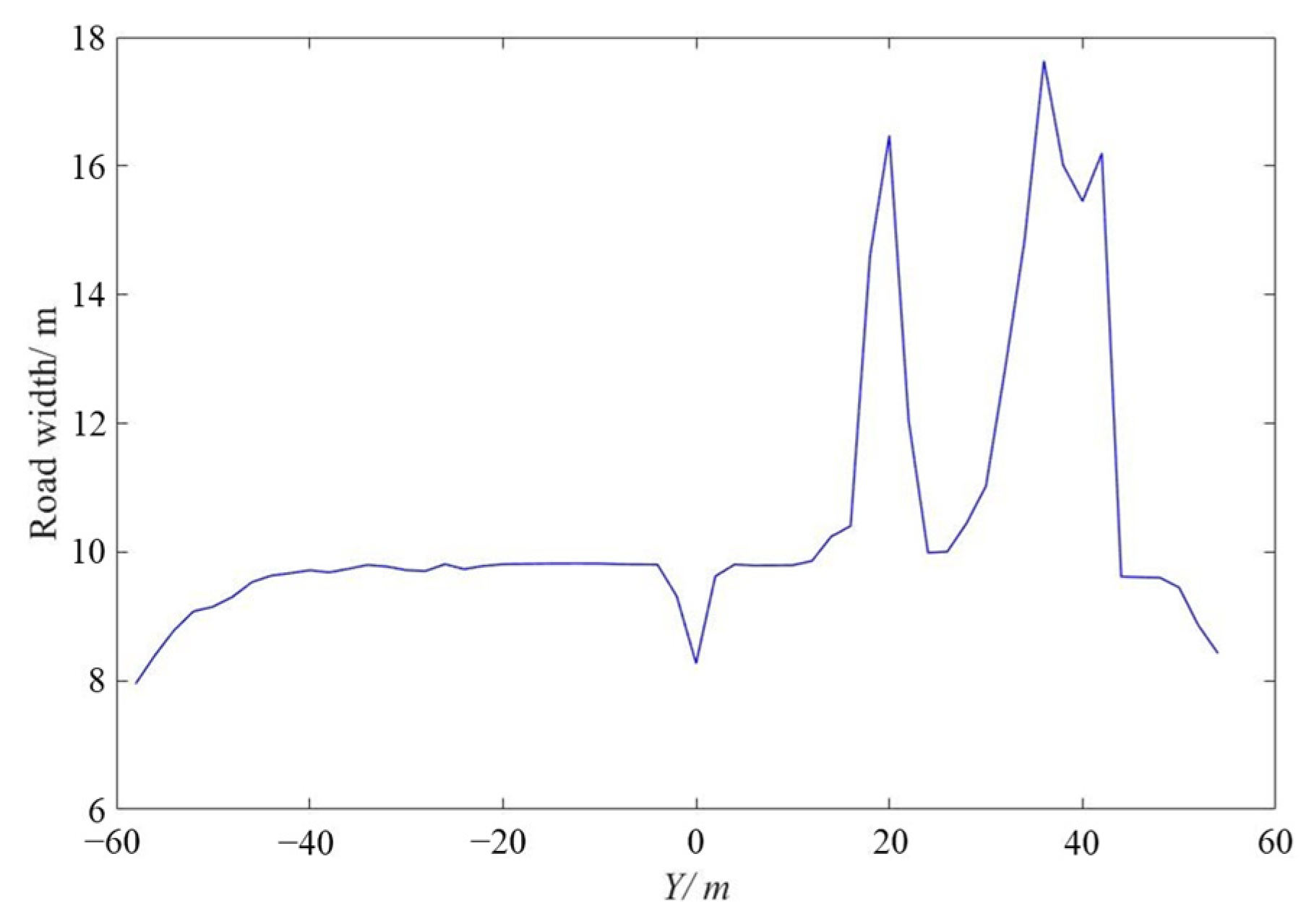



| Method | mIoU (%) | OA (%) | IoU (%) | |||||||
|---|---|---|---|---|---|---|---|---|---|---|
| Road Surface | Road Mrk. | Natural. | Building | Util. Line | Pole | Car | Fence | |||
| Pointnet++ | 65.0 | 93.0 | 93.9 | 19.4 | 90.5 | 81.7 | 68.5 | 62.9 | 58.9 | 44.4 |
| RandLA-Net | 74.3 | 88.4 | 87.4 | 22.0 | 96.4 | 92.7 | 85.9 | 75.5 | 86.6 | 47.6 |
| SCF-Net | 71.5 | 93.5 | 91.4 | 19.6 | 90.9 | 87.3 | 78.5 | 72.6 | 84.6 | 47.4 |
| Ours | 73.9 | 95.3 | 95.7 | 25.9 | 94.0 | 86.3 | 81.5 | 71.8 | 78.1 | 58.1 |
| Method | mIoU (%) | OA (%) | IoU (%) | |||||||
|---|---|---|---|---|---|---|---|---|---|---|
| Road Surface | Natural. | High Veg. | Low Veg. | Building | Infrastructure | Scanning Art. | Cars | |||
| Pointnet++ | 63.1 | 85.7 | 81.9 | 78.1 | 64.3 | 51.7 | 75.9 | 36.4 | 43.7 | 72.6 |
| RandLA-Net | 71.8 | 94.2 | 96 | 88.6 | 65.3 | 62.0 | 95.9 | 49.8 | 27.8 | 89.3 |
| Ours | 74.7 | 95.0 | 97.9 | 94.1 | 70.8 | 64.3 | 94.0 | 48.5 | 38.8 | 89.2 |
| Indicators | Geometric Information | |||
|---|---|---|---|---|
| Road Width/m | Longitudinal Gradient/% | Cross Slope | ||
| Left Cross Slope/% | Right Cross Slope/% | |||
| Mean absolute error | 0.0094 | 0.0091 | 0.0074 | 0.0073 |
| Maximum absolute error | 0.0530 | 0.0475 | 0.0238 | 0.0237 |
| Location of Maximum absolute error/m | 36 | 30 | 20 | 20 |
| Location/m | Road Width/m | Longitudinal Gradient/% | ||||
|---|---|---|---|---|---|---|
| Extracted Methods | Manual Measurement | Absolute Error | Extracted Methods | Manual Measurement | Absolute Error | |
| 20 | 16.4723 | 16.4228 | 0.0495 | −0.2728 | −0.2700 | 0.0028 |
| 22 | 12.0468 | 12.0348 | 0.0121 | −1.9862 | −1.9663 | 0.0199 |
| 24 | 9.9901 | 9.9931 | 0.0030 | −0.5564 | −0.5553 | 0.0011 |
| 26 | 10.0043 | 9.9944 | 0.0100 | −2.1261 | −2.1304 | 0.0043 |
| 28 | 10.4480 | 10.4376 | 0.0104 | −3.0431 | −3.0431 | 0.0000 |
| 30 | 11.0251 | 11.0140 | 0.0110 | −4.7629 | −4.8104 | 0.0475 |
| 32 | 12.8570 | 12.8312 | 0.0257 | −4.4626 | −4.5072 | 0.0446 |
| 34 | 14.8429 | 14.8132 | 0.0297 | −1.9402 | −1.9594 | 0.0192 |
| 36 | 17.6331 | 17.5801 | 0.0530 | −4.3765 | −4.4198 | 0.0433 |
| 38 | 16.0092 | 15.9611 | 0.0481 | −0.5631 | −0.5687 | 0.0056 |
| 40 | 15.4505 | 15.4195 | 0.0310 | −0.5698 | −0.5641 | 0.0057 |
| Location/m | Left cross slope/% | Right cross slope/% | ||||
| Extracted methods | Manual measurement | Absolute error | Extracted methods | Manual measurement | Absolute error | |
| 20 | 2.0960 | 2.1198 | 0.0238 | 2.0904 | 2.1141 | 0.0237 |
| 22 | 2.1436 | 2.1661 | 0.0225 | 2.0253 | 2.0465 | 0.0212 |
| 24 | 2.1628 | 2.1582 | 0.0046 | 1.8497 | 1.8457 | 0.0040 |
| 26 | 2.2789 | 2.2755 | 0.0034 | 1.7042 | 1.7017 | 0.0025 |
| 28 | 2.4485 | 2.4497 | 0.0012 | 1.6568 | 1.6577 | 0.0009 |
| 30 | 2.4504 | 2.4271 | 0.0233 | 1.8162 | 1.7989 | 0.0173 |
| 32 | 2.5608 | 2.5377 | 0.0231 | 1.7056 | 1.6902 | 0.0154 |
| 34 | 2.3259 | 2.3047 | 0.0212 | 2.1679 | 2.1482 | 0.0197 |
| 36 | 2.1869 | 2.1680 | 0.0189 | 2.2000 | 2.1810 | 0.0190 |
| 38 | 2.2301 | 2.2108 | 0.0193 | 2.3062 | 2.2863 | 0.0199 |
| 40 | 2.0245 | 2.0465 | 0.0220 | 1.4223 | 1.4378 | 0.0155 |
Disclaimer/Publisher’s Note: The statements, opinions and data contained in all publications are solely those of the individual author(s) and contributor(s) and not of MDPI and/or the editor(s). MDPI and/or the editor(s) disclaim responsibility for any injury to people or property resulting from any ideas, methods, instructions or products referred to in the content. |
© 2023 by the authors. Licensee MDPI, Basel, Switzerland. This article is an open access article distributed under the terms and conditions of the Creative Commons Attribution (CC BY) license (https://creativecommons.org/licenses/by/4.0/).
Share and Cite
Wang, Y.; Wang, W.; Liu, J.; Chen, T.; Wang, S.; Yu, B.; Qin, X. Framework for Geometric Information Extraction and Digital Modeling from LiDAR Data of Road Scenarios. Remote Sens. 2023, 15, 576. https://doi.org/10.3390/rs15030576
Wang Y, Wang W, Liu J, Chen T, Wang S, Yu B, Qin X. Framework for Geometric Information Extraction and Digital Modeling from LiDAR Data of Road Scenarios. Remote Sensing. 2023; 15(3):576. https://doi.org/10.3390/rs15030576
Chicago/Turabian StyleWang, Yuchen, Weicheng Wang, Jinzhou Liu, Tianheng Chen, Shuyi Wang, Bin Yu, and Xiaochun Qin. 2023. "Framework for Geometric Information Extraction and Digital Modeling from LiDAR Data of Road Scenarios" Remote Sensing 15, no. 3: 576. https://doi.org/10.3390/rs15030576
APA StyleWang, Y., Wang, W., Liu, J., Chen, T., Wang, S., Yu, B., & Qin, X. (2023). Framework for Geometric Information Extraction and Digital Modeling from LiDAR Data of Road Scenarios. Remote Sensing, 15(3), 576. https://doi.org/10.3390/rs15030576








